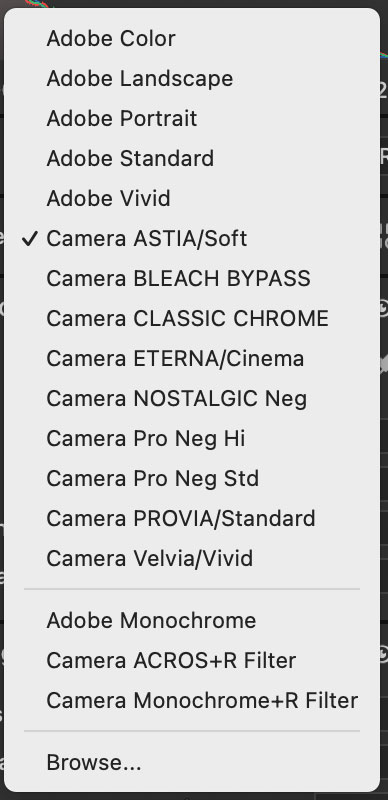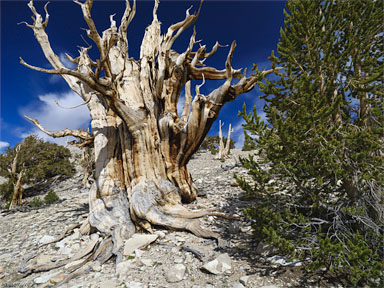Fujifilm GFX100S: Camera Profiles in Adobe Camera Raw
Dr S writes:

Screw everything else. The visual impact is outstanding! The deep blue sky is perfect.
I own and have used other major cam brands (some current including Sony and Nikon. I don't think I am being unrealistic but it seems a Fujifilm camera gets colors to pop more. Please tell me I am wrong and one can get the same results with similar post processing.
DIGLLOYD: over the years, I keep getting comments along the lines of “the color of Camera X is Better than Camera Y”.
Since most of today’s cameras use nearly identical sensor technology, that makes little sense: camera electronics are not altering color (for RAW) but translating analog signals into digital bits, doing it a little clearer/better or not. All (or nearly all) of the look-and-feel happens during raw conversion.
There are two key factors involved in how an image looks: (1) the RAW converter, and (2) the Profile applied to the raw image in that raw converter...
Fujifilm GFX100/GFX100S/100 II: Camera Profiles Renditions
I discuss 14 different Profile renditions, which camera I tend to use, and why.
Related screencasts:
diglloyd Making Sharp Images: Adobe Camera Raw: Changing Image Look & Feel Using Camera Profile
diglloyd Patreon.com: Adobe Camera Raw: Changing Image Look & Feel Using Camera Profile
Rich S writes:
I have had the same experience in my fine art print work and working on student files during workshops. This includes spending hours working on single files, with great scrutiny of color, and printing multiple proofs of said files to take them to museum level. I have been able to produce almost identical color from multiple brands. Sony and the pro Nikons are extremely similar for example, most likely because both sensors are made by Sony.
I believe the “better color science” claims come from comparing the rendering from the camera profiles, not from processing the files to the same point. There are subtle differences between brands and even models. For instance I can see the improvements from say a Nikon D800 to the Nikon D810, and then the D850, but they are small leaps forward and few can see color with that degree of accuracy.The latest Z camera all look like the D850 to me, and yet to see a meaningful difference from the D850 in terms of sensor quality.
Also, part of the difference appears to be due to improvements in noise in each sensor, as there is a distinct difference in the noise pattern in a d800 vs even a d810. The Fuji medium format line does an astounding job of recreating the Fujichrome look, and if you want the Fujichrome look, Fuji is the way to go. Canon color always seems a little off to me, particularly the dSLRs, in that they don’t seem to capture the same subtlety of colors and range of colors, and also much higher noise. Even their most current mirrorless don’t seem as good as Sony/Nikon/ Fuji Medium format. I know many portrait photographers like the Canon look, but for landscape, I’d much rather have a Sony sensor camera. I also wish Fujifilm would abandoned the XTrans sensor in their smaller format cameras, as they rarely give me what I have come to expect from other brand sensors.
DIGLLOYD: and now with AI Denoise, the color is also affected, with subtle shifts (or maybe a reversion to something less polluted), as the noise is removed. The higher the ISO, the more noticeable.
There is also pixel shift, when it can be used, which gives more accurate and cleaner color.
The new Fujifilm GFX100 II does special things to the black level (truncates thenoise off ) and IMO this accentuates and improves the color. That changes color perception; the GFX100 II images seem more pleasing perceptually. Sony could do something similar, but sits around with its thumb up its ass as to firmware improvements in many areas.
I agree that there are differences when one spans sensor technologies across time or vendor, but that today there are few such differences, since the market is dominated by Sony sensors.
Finally, specialty sensors as in the PhaseOne TriChromatic almost certainly do different things.
...And Topaz telling people to just shoot at 12,000 ISO and then denoise. Facepalm. What a tangled web they weave. It is amazing how many of my students would see a 400% improvement by just using a tripod and base ISO. Their view of what is “right” is based on underexposed high ISO with a mid range lens. Honestly Lloyd, few people even know what is possible and how good a photo can look.
Most people think the manure that the iPhone produces is high quality, because a 14MP image is crammed into a glorified postage stamp screen. By tweaking the coarse and medium contrast and doing a great job on color, the hideously mangled details are effectively hidden.

Fujifilm GFX100S + GF20-35mmF4 R WR @ 19.3mm equiv (23.4mm)
ENV: White Mountains, altitude 11700 ft / 3566 m, 60°F / 15°C
RAW: Camera ASTIA, Enhance Details, LACA corrected, vignetting corrected, WB 4850°K tint 23, +50 Shadows, +20 Whites, +10 Clarity, AI Denoise 10, diffraction mitigating sharpening, +10 Vibrance
[low-res image for bot]























